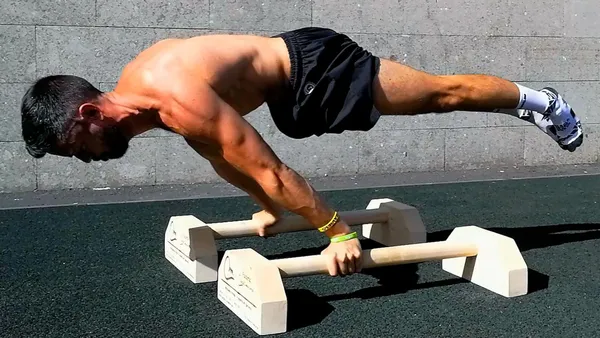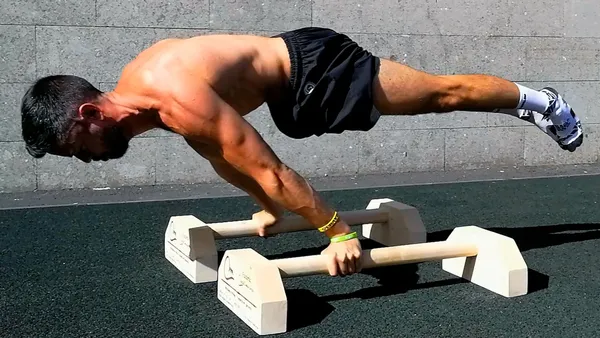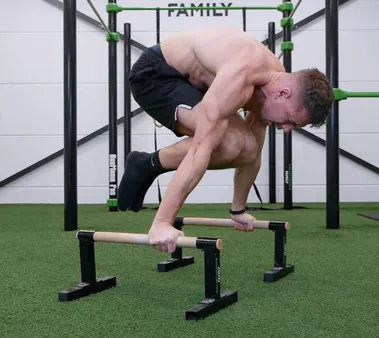Table of Contents
If you're looking to take your calisthenics training to the next level, then mastering the planche is a must. This advanced bodyweight exercise requires immense strength, flexibility, and coordination, and it's sure to turn heads when you can hold it effortlessly. On Kizworld, we're dedicated to providing you with all the information and resources you need to achieve your fitness goals, and in this article, we'll delve deep into the world of planche calisthenics, covering everything from the benefits and variations to the training and progressions you need to master this incredible feat of strength.
The Ultimate Planche Calisthenics Guide: Master the Human Flag and Beyond
Feature | Planche Calisthenics |
|---|---|
Definition | Advanced calisthenics move involving holding a horizontal position supported by the hands |
Benefits | Enhanced shoulder, core, and back strength; improved stability and flexibility; impressive aesthetics |
Required Strength | Advanced upper body and core strength; strong shoulders, triceps, and abs |
Training | Gradual progression with preparatory exercises and variations; regular practice and dedication |
Variations | Full Planche, Advanced Tuck Planche, Straddle Planche, One-Arm Planche |
Tips for Mastering | Focus on shoulder flexibility, core strength, and tricep endurance; use spotters and mats for safety |
I. Planche Calisthenics: A Comprehensive Guide to Mastering the Human Flag
What is Planche Calisthenics?
Planche calisthenics is an advanced calisthenics move that involves holding a horizontal position supported by the hands. It is a challenging move that requires a great deal of strength, flexibility, and coordination. The planche is often considered to be the "holy grail" of calisthenics, and it is a move that many calisthenics athletes aspire to master.
Benefits of Planche Calisthenics
There are many benefits to practicing planche calisthenics. These benefits include:
- Increased strength in the shoulders, core, and back
- Improved flexibility and stability
- Enhanced aesthetics
The planche is a full-body exercise that works multiple muscle groups simultaneously. It is a great way to build strength, improve flexibility, and get in shape.
How to Master the Planche Calisthenics
Mastering the planche calisthenics takes time and dedication. There is no one-size-fits-all approach to training for the planche, but there are some general principles that you can follow. These principles include:
- Start with preparatory exercises
- Progress gradually
- Be patient and consistent
It is important to start with preparatory exercises that will help you to develop the strength and flexibility that you need for the planche. These exercises include things like the tuck planche, the advanced tuck planche, and the straddle planche. Once you have mastered these exercises, you can begin to progress to the full planche.It is important to progress gradually when training for the planche. Do not try to do too much too soon, or you will risk injury. Start with a few sets of each exercise, and gradually increase the number of sets and repetitions as you get stronger.Be patient and consistent with your training. It takes time to master the planche, so do not get discouraged if you do not see results immediately. Just keep practicing, and you will eventually achieve your goal.
Exercise | Sets | Repetitions |
|---|---|---|
Tuck Planche | 3 | 10-12 |
Advanced Tuck Planche | 3 | 8-10 |
Straddle Planche | 3 | 6-8 |
If you are struggling to master the planche, there are a few things that you can do. First, make sure that you are using proper form. Second, try using a spotter to help you. Third, be patient and consistent with your training. With time and effort, you will eventually achieve your goal.How to Do a Muscle UpThe Best Calisthenics Gifts and Accessories
Planche Calisthenics: A Comprehensive Guide to Mastering the Human Flag
II. The Benefits of Planche Calisthenics: Strength, Flexibility, and Aesthetics
Unveiling the Strength-Building Power of Planche Calisthenics
Planche calisthenics, a demanding discipline within the calisthenics realm, offers a plethora of benefits that extend beyond aesthetics. It is an exceptional exercise for developing remarkable upper body and core strength. By holding the body in a horizontal position supported solely by the hands, planche calisthenics engages various muscle groups, leading to significant strength gains. This exercise particularly targets the shoulders, triceps, and abdominal muscles, resulting in enhanced stability and control over body movements.
One of the primary advantages of planche calisthenics is its ability to enhance shoulder strength. The movement requires the shoulders to support the entire weight of the body, promoting shoulder stability and mobility. Regular practice of planche calisthenics strengthens the rotator cuff muscles, which are crucial for maintaining shoulder health and preventing injuries. Additionally, it improves shoulder flexibility, allowing for a greater range of motion and reduced risk of muscle strains.
Read more about the best calisthenics exercises and variations
Unlocking Flexibility and Aesthetic Appeal through Planche Calisthenics
In addition to its strength-building prowess, planche calisthenics also offers significant benefits for flexibility and aesthetics. The movement requires the practitioner to maintain a straight body line while holding the horizontal position, which promotes spinal flexibility and reduces the risk of back pain. Furthermore, it enhances hip and ankle flexibility, improving overall mobility and reducing the likelihood of injuries during other physical activities.
From an aesthetic standpoint, planche calisthenics helps to develop a lean and toned physique. The exercise targets multiple muscle groups simultaneously, leading to a balanced and well-proportioned body. Regular practice of planche calisthenics can result in noticeably defined shoulders, triceps, and abdominal muscles. Additionally, it improves posture, giving practitioners a more confident and athletic appearance.
Learn more about the best calisthenics apps and websites
Benefit | Impact |
|---|---|
Strength | Enhanced upper body and core strength |
Flexibility | Increased spinal, hip, and ankle flexibility |
Aesthetics | Lean and toned physique with defined muscles |
The Benefits of Planche Calisthenics: Strength, Flexibility, and Aesthetics
III. Mastering the Planche Calisthenics Progression: From Beginner to Advanced
Mastering the planche calisthenics is a challenging but rewarding endeavor that requires dedication, patience, and a systematic approach. The progression from beginner to advanced involves gradually increasing the difficulty of exercises and variations to build the necessary strength, flexibility, and coordination.For beginners, it's crucial to start with preparatory exercises that strengthen the shoulders, core, and triceps. These exercises include pike push-ups, shoulder taps, and L-sits. As you progress, you can incorporate more advanced variations such as the tuck planche, advanced tuck planche, straddle planche, and eventually, the full planche.Throughout the progression, it's essential to focus on proper form and technique to minimize the risk of injury. This includes maintaining a neutral spine, engaging the core, and keeping the shoulders depressed and protracted. Additionally, using spotters and mats for safety is highly recommended, especially when attempting advanced variations.Regular practice and consistency are key to success in mastering the planche calisthenics. Aim for at least three training sessions per week, focusing on compound exercises that target multiple muscle groups. Gradually increase the intensity and duration of your workouts as you get stronger.Remember, mastering the planche calisthenics is a journey that takes time and effort. By following a structured progression, incorporating preparatory exercises, and maintaining proper form, you can gradually build the necessary strength, flexibility, and coordination to achieve this impressive feat of human movement.
Planche Calisthenics Progression | Exercises |
|---|---|
Beginner | Pike push-ups, shoulder taps, L-sits |
Intermediate | Tuck planche, advanced tuck planche |
Advanced | Straddle planche, full planche |
Related post: How to Do a Muscle Up: A Step-by-Step Guide
- Start with preparatory exercises to build a foundation of strength and flexibility.
- Gradually increase the difficulty of exercises and variations as you progress.
- Focus on proper form and technique to minimize the risk of injury.
- Use spotters and mats for safety, especially when attempting advanced variations.
- Be patient and consistent with your training, and you will eventually achieve your goal.
IV. Planche Calisthenics Variations: Exploring Different Forms of the Human Flag
Planche calisthenics is an advanced form of bodyweight training that involves holding a horizontal position supported by the hands. It is a challenging move that requires a great deal of strength, flexibility, and coordination. There are several different variations of the planche, each with its own unique challenges and benefits.One of the most popular variations of the planche is the full planche. This variation involves holding a horizontal position with the body fully extended. The full planche is a very difficult move to master, but it is also one of the most impressive.Another popular variation of the planche is the advanced tuck planche. This variation involves holding a horizontal position with the knees bent and the feet tucked close to the body. The advanced tuck planche is less difficult than the full planche, but it is still a challenging move that requires a great deal of strength and flexibility.The straddle planche is another variation of the planche that is popular among calisthenics enthusiasts. This variation involves holding a horizontal position with the legs spread apart. The straddle planche is less difficult than the full planche or the advanced tuck planche, but it is still a challenging move that requires a great deal of strength and flexibility.The one-arm planche is the most difficult variation of the planche. This variation involves holding a horizontal position with only one arm supporting the body. The one-arm planche is a very challenging move that requires a great deal of strength, flexibility, and coordination.If you are interested in learning how to do planche calisthenics, there are a few things you should keep in mind. First, it is important to start with the basics and gradually work your way up to the more difficult variations. Second, it is important to be patient and consistent with your training. Finally, it is important to listen to your body and rest when you need to.With hard work and dedication, you can learn how to do planche calisthenics and achieve your fitness goals.
Planche Variation | Difficulty | Benefits |
|---|---|---|
Full Planche | Very difficult | Impressive aesthetics, enhanced shoulder, core, and back strength |
Advanced Tuck Planche | Less difficult than full planche | Improved shoulder flexibility, core strength, and tricep endurance |
Straddle Planche | Less difficult than full planche or advanced tuck planche | Enhanced shoulder stability, increased flexibility, improved core strength |
One-Arm Planche | Most difficult variation | Impressive aesthetics, ultimate test of strength, flexibility, and coordination |
Here are some tips for mastering the planche calisthenics:* Focus on shoulder flexibility, core strength, and tricep endurance.* Use spotters and mats for safety.* Be patient and consistent with your training.* Listen to your body and rest when you need to.With hard work and dedication, you can learn how to do planche calisthenics and achieve your fitness goals.How to Do a Muscle UpThe Best Calisthenics Gifts and Accessories
Planche Calisthenics Variations: Exploring Different Forms of the Human Flag
V. Conclusion
Planche calisthenics exercises demand a high level of strength, skill, and flexibility. They provide numerous benefits, including improved posture, enhanced balance and coordination, increased joint mobility, and reduced risk of injury. By progressively overloading and varying your planche practice, you can continually challenge yourself and unlock your full potential. Whether you're just starting out or are an experienced calisthenics enthusiast, incorporate planche exercises into your routine to elevate your fitness and reap the rewards.